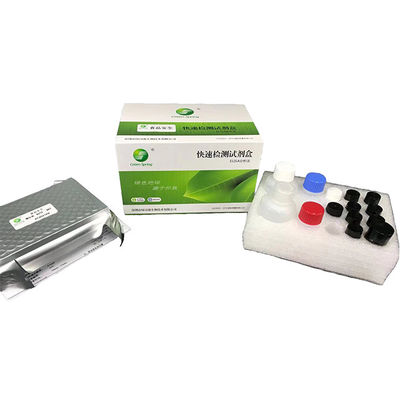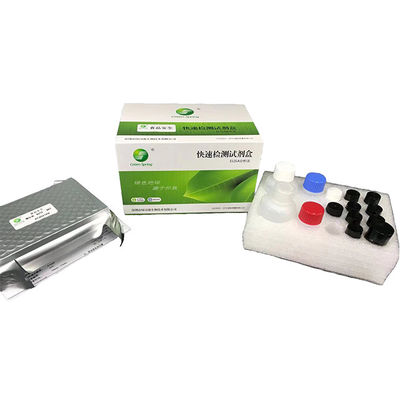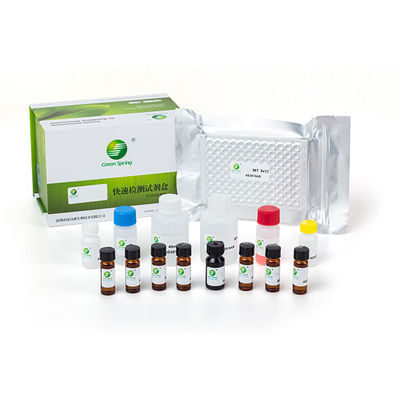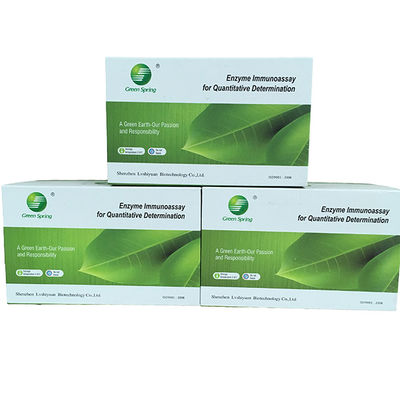|
|
Ochratoxin A ELISA Test Kit short time incubation 15min-5min for grain feed
Product Details:
Payment & Shipping Terms:
|
| Specification: | 96 Wells/kit | Sensitivity: | 0.1ppb |
|---|---|---|---|
| Incubator Temperature: | 25℃ | Incubator Time: | 15min~5min |
| Shelf Life: | 12 Months When Properly Stored | Sample Performance: | Feed, Grain |
| Detection Limit: | 4ppb | Recovery Rate: | 95±25% |
Ochratoxin A ELISA Test Kit
Catalog No. LSY-10034B
1. Principle
This test kit is based on the indirect competitive enzyme immunoassay for the detection of Ochratoxin A. The coupling antigen is pre-coated on the micro-well stripes. The Ochratoxin A in the sample and the coupling antigens pre-coated on the micro-well stripes compete for the anti- Ochratoxin A antibodies. After the addition of the enzyme conjugate, the TMB substrate is added for coloration. The optical density (OD) value of the sample has a negative correlation with the Ochratoxin A in the sample. This value is compared to the standard curve and the Ochratoxin A residues is subsequently obtained.
2. Technical specifications
Sensitivity: 0.1 ppb
Incubator temperature: 25℃
Incubator time: 15min~5min
Detection limit:
Feed, grain…………………….................................................………….4ppb
Cross-reaction rate:
Ochratoxin A…............................................................................ ….100%
Recovery rate:
Feed, grain………………………...............................................………95±25%
- Components
| 1 | Micro-well strips | 12 strips with 8 removable wells each | |
| 2 | 5× standard solution (1 mL each) | 0ppb | 0.1ppb |
| 0.3ppb | 0.9ppb | ||
| 2.7ppb | |||
| 3 | Enzyme conjugate | 7ml | red cap |
| 4 | Antibody working solution | 7ml | blue cap |
| 5 | Substrate A | 7ml | white cap |
| 6 | Substrate B | 7ml | black cap |
| 7 | Stop solution | 7ml | yellow cap |
| 8 | 20× concentrated washing buffer | 40ml | white cap |
| 9 | 2× concentrated redissolving solution | 50ml | transparent cap |
4. Materials required but not provided
1) Equipment: ELISA Reader (450nm/630nm), homogenizer, shaker, centrifuge, balance: 0.01g quantity sensitive, incubator, graduated pipettes, printer
2) Micropipettes: single-channel 20ml ~ 200ml, 100ml ~ 1000ml, multi-channel 30~300μl
3) Reagents: Methanol.
- Sample pre-treatment
Instructions (The following points must be dealt with before the pre-treatment)
- Only the disposable tips can be used for the experiments and the tips must be changed when used for absorbing different reagents;
2) Before the experiment, each experimental utensil must be clean and should be re-cleaned if necessary, in order to avoid the contamination that interferes with the experimental results.
Solution preparation before sample pre-treatment:
1) Sample redissolving solution
Use 1 part of 2X concentrated redissolving solution and dissolve with 1 part of deionized water to obtain the ready to use sample redissolving solution.
2) Sample extract solution
Use 7 parts of Methanol and dissolve with 3 parts of deionized water to obtain the ready to use sample extract solution.
Samples Preparation
- Preparation of feed, grain sample
- Take 5.0±0.05g homogenized sample into 50ml centrifuge tube, add 25ml Sample extract solution, vortex oscillation for 3min, centrifuge at above 4000r/min at room temperature for 5 min;
- Take 100ul supernatant into a new centrifuge tube, add 700ul Sample redissolving solution, vortex for 1min to be evenly;
- Take 50μl to test
Dilution factor: 40
6. ELISA procedures
6.1 Instructions
1. Bring ELISA reagents to room temperature (20 - 25 °C) before use.
2. Put ELISA reagents back to 2-8 ℃ immediately after use
3. The ELISA reproducibility in the analysis process is largely depends on the consistency of the washing plate, the correct washing plate operation is the point of determination ELISA program
4. In all process of constant temperature incubation, avoid light exposure, seal the microplate with the cover membrane
6. 2 Operation procedures
1. Bring test kit to the room temperature (20-25 ℃) for at least 30 min, note that each reagent must be shaken evenly before use;
2. Put the required micro-well strips into plate frames. Re-sealed the unused microplate, stored at 2-8 ℃, not frozen.
3. Solution preparation: take the 40ml 20× concentrated washing buffer, dissolve with deionized water at 1:19 (1 part 20× concentrated washing buffer + 19 parts deionized water), or prepare as quantity needed.
4. Numbering: number the micro-wells according to samples and standard solution; each sample and standard solution should be performed in duplicate; record their positions.
5. Add standard/sample: Add 50 µL of the sample or the standard solution into separate duplicate wells, then add enzyme conjugate, 50 µL/well; then antibody working solution, 50 µL/well. Mix gently by shaking the plate manually, seal the microplate with the cover membrane, incubate at 25 °C for 15 min in the dark.
6. Wash microplate: Carefully open the cover membrance, pour liquid out of microwell; add 250 µL/well of washing buffer, wash fully for 4-5 times, 15-30 s each time, then take out and flap to dry with absorbent paper.(Use unused spear to pierce bubble after dry)
7. Coloration: firstly add 50 µL of substrate A solution then 50 µL substrate B solution into each well. Mix gently by shaking the plate manually, and incubate at 25 °C for 5min in the dark for coloration.
8. Determination: add 50 µL of the stop solution into each well. Mix gently by shaking the plate manually. Set the wavelength of the microplate reader at 450nm to determine the OD value of every well. (Recommend to read the OD value at the dual-wavelength 450/630nm within 5 min).
7. Result judgment
There are two methods to judge the results; the first one is the rough judgment, while the second is the quantitative determination. Note that the OD value of the sample has a negative correlation with the Ochratoxin A in the sample
7.1 Qualitative determination
The concentration range (ppb) can be obtained by compared the average absorbance value with standards. Suppose absorbance value of Sample One is 0.3, Sample Two is 1.0, and the standards are: 0ppb of 1.953; 0.1ppb of 1.585; 0.3ppb of 1.256; 0.9ppb of 0.626; 2.7ppb of 0.253. Then the concentration of the sample one is in the range of 0.9ppb ~ 2.7ppb; Sample Two is 0.3ppb ~ 0.9ppb. The concentration range of Ochratoxin A in the samples can be obtained by multiplied by the corresponding dilution of the sample.
7. 2 Quantitative Analysis
In order to calculate the concentration of samples, a standard curve should be made. Before standard curve is made, the concept of % absorbance should be known.
Calculation of % absorbance:
| Percentage of absorbance value = | B | ×100% |
| B0 |
B—the average OD value of the sample or the standard solution
B0—the average OD value of the 0 ng/mL standard solution
The zero standard is thus made equal to 100 % and the absorbance values are quoted in percentages. The values calculated for the standards are entered in a system of coordinates on semilogarithmic graph paper against the Ochratoxin A concentration [ng/ml]. The Ochratoxin A concentration in ng/ml (ppb) corresponding to the absorbance of each sample can be read from the calibration curve.
A special software for result analysis of ELISA will facilitate double or multiple determinations. If you need, please call to request.
8. Precautions
1. The room temperature below 25 ℃ or the temperature of the reagents and the samples being not returned to the room temperature (20-25 ℃) will lead to a lower standard OD value.
2. Dryness of the microplate in the washing process will be accompanied by the situations including the non-linear standard curves and the undesirable reproducibility; So continue to next step immediately after washing.
3. Mix evenly before adding any reagents.
4. The stop solution is the 2 M sulfuric acid solution, avoid contacting with the skin.
5. Do not use the kit exceeding its expiry date. The use of diluted or adulterated reagents from the kits will lead to the changes in the sensitivity and the detecting OD values. Do not exchange the reagents from the kits of different lot numbers to use.
6. Storage: store at 2-8 ℃, not frozen. Put the unused microplate into an auto-sealing bag to re-seal it. The standard substance and the colorless color former is light sensitive, and thus they cannot be directly exposed to the light.
7. Discard the coloration solution with any color that indicates the degeneration of this solution. The detecting value(450/630nm) of the 0 standard solution (0 ppb) of less than 0.5((A450nm<0.5)) indicates its degeneration.
8. The optimum reaction temperature is 25 ℃, and too high or too low temperatures will result in the changes in the detecting sensitivity and OD values.
9. Storage and expiry date
Storage: store at 2-8 ℃, not frozen.
Expiry date: 12 months; date of production is on box.
Note: If the Vacuum package of microplate has leakage, it is still valid to use, do not affect the test result, be relax to use.
Shenzhen Lvshiyuan Biotechnology Co.,Ltd
D Building, National Biological Industrial Park of Marinelife, No.2 Binhai Road, Dapeng, Shenzhen, 518120 China
Tel. 86-755-28438788
Fax 86-755-28938800
Email: info@lsybt.com
www.lsybt.com
![]()
-
Ochratoxin A fluorescence quantitative rapid test card for chili powder
-
Ochratoxin A (OTA) fluorescence quantitative rapid test card Detection limit: 5μg/kg(ppb) for grains and feed
-
Fumonisins fluorescence quantitative rapid test card for grains, corn, soybean Detection limit: 250μg/kg(ppb)
-
Trichothecenes (T-2) fluorescence quantitative rapid test card Detection limit: 40μg/kg(ppb)
-
Zearalenone(ZEN) fluorescence quantitative rapid test card rapid quantitative detection of Zearalenone(ZEN) in grains
-
Deoxynivalenol(DON) fluorescence quantitative rapid test card rapid quantitative detection of Deoxynivalenol in grains









